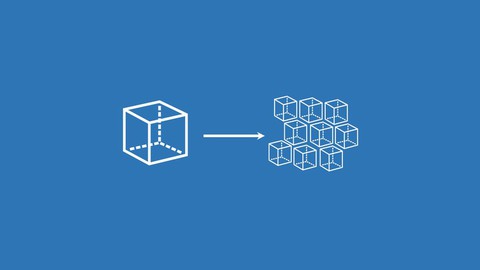
Introduction to Microservices using .NET Core 3.1
Introduction to Microservices using .NET Core 3.1, available at $69.99, has an average rating of 4.25, with 102 lectures, 8 quizzes, based on 132 reviews, and has 813 subscribers.
You will learn about Fundamentals of Microservices architecture. Implement API Gateway using ASP .NET Core Application. Connect Microservice with NoSQL database MongoDB. How to Structure Microservice Project using ASP .Net Core Application Develop microservices with ASP .NET Core Web APIs Postman tool installation and Basics. Install RabbitMQ to implement event based communication in microservice architecture. Install Masstransit to communicate with RabbitMQ Message Broker from Application. Fundamentals of AMQP (Advanced Message Queuing Protocol) and RabbitMQ. Communicate between API Gateway and microservices using RabbitMQ with Masstransit. Create Masstransit Consumers to consume published messages. Fundamentals of CQRS (Command Query Segregation Principle). Refactor application as per CQRS Design (Physical layer Separation). Implement Authentication and Authorization Mechanism using JWT Token. Basics of Unit Testing. Unit testing Product Controller with nUnit. Unit Testing Login method using Masstransit In-Memory test harness. What is Benchmarking and Apache Bench Installation to micro-benchmark our application. What is Resiliency in microservices and need of Resilient Microservices. Basics of Polly (A transient fault handling library). Implementation of Fallback Policy. Implementation of Retry Policy. How to wrap multiple policies as one using Wrap Policy. What is Jittering and implementation of Wait Retry Policy. What is Circuit Breaker Pattern. Implementation of Circuit Breaker Pattern using Circuit Breaker Policy. Implementation of Advance Circuit Breaker Policy. What is Bulkhead Isolation. Implementation of Bulk Isolation Policy. Basics of Redis and its installation. Create Cart Service using In-memory database Redis. Swagger Implementation for Order service to document Order API endpoints. What is Distributed Transaction in microservices. Distributed Transaction Techniques. (2-Phase Commit & Saga) – Theory What is Routing Slip Pattern. Implementing Routing Slip pattern using Masstransit Courier to handle distributed transaction. (Long lived transactions are not covered). Monitoring Routing Slip Execution with help of Routing Slip Events. Implementation of idempotent services using Idempotent consumer pattern. This course is ideal for individuals who are ASP .Net Developer who want to learn microservices architecture using .Net Core. It is particularly useful for ASP .Net Developer who want to learn microservices architecture using .Net Core.
Enroll now: Introduction to Microservices using .NET Core 3.1
Summary
Title: Introduction to Microservices using .NET Core 3.1
Price: $69.99
Average Rating: 4.25
Number of Lectures: 102
Number of Quizzes: 8
Number of Published Lectures: 102
Number of Published Quizzes: 8
Number of Curriculum Items: 110
Number of Published Curriculum Objects: 110
Original Price: ₹3,999
Quality Status: approved
Status: Live
What You Will Learn
- Fundamentals of Microservices architecture.
- Implement API Gateway using ASP .NET Core Application.
- Connect Microservice with NoSQL database MongoDB.
- How to Structure Microservice Project using ASP .Net Core Application
- Develop microservices with ASP .NET Core Web APIs
- Postman tool installation and Basics.
- Install RabbitMQ to implement event based communication in microservice architecture.
- Install Masstransit to communicate with RabbitMQ Message Broker from Application.
- Fundamentals of AMQP (Advanced Message Queuing Protocol) and RabbitMQ.
- Communicate between API Gateway and microservices using RabbitMQ with Masstransit.
- Create Masstransit Consumers to consume published messages.
- Fundamentals of CQRS (Command Query Segregation Principle).
- Refactor application as per CQRS Design (Physical layer Separation).
- Implement Authentication and Authorization Mechanism using JWT Token.
- Basics of Unit Testing.
- Unit testing Product Controller with nUnit.
- Unit Testing Login method using Masstransit In-Memory test harness.
- What is Benchmarking and Apache Bench Installation to micro-benchmark our application.
- What is Resiliency in microservices and need of Resilient Microservices.
- Basics of Polly (A transient fault handling library).
- Implementation of Fallback Policy.
- Implementation of Retry Policy.
- How to wrap multiple policies as one using Wrap Policy.
- What is Jittering and implementation of Wait Retry Policy.
- What is Circuit Breaker Pattern.
- Implementation of Circuit Breaker Pattern using Circuit Breaker Policy.
- Implementation of Advance Circuit Breaker Policy.
- What is Bulkhead Isolation.
- Implementation of Bulk Isolation Policy.
- Basics of Redis and its installation.
- Create Cart Service using In-memory database Redis.
- Swagger Implementation for Order service to document Order API endpoints.
- What is Distributed Transaction in microservices.
- Distributed Transaction Techniques. (2-Phase Commit & Saga) – Theory
- What is Routing Slip Pattern.
- Implementing Routing Slip pattern using Masstransit Courier to handle distributed transaction. (Long lived transactions are not covered).
- Monitoring Routing Slip Execution with help of Routing Slip Events.
- Implementation of idempotent services using Idempotent consumer pattern.
Who Should Attend
- ASP .Net Developer who want to learn microservices architecture using .Net Core.
Target Audiences
- ASP .Net Developer who want to learn microservices architecture using .Net Core.
-
Learn the basics of microservices and what problem it solves.
-
Learn the basics of the components of the microservices (API Gateway, Message Brokers, Services, Database).
-
Implement a microservice architecture with event-driven communication using ASP.NET Core, RabbitMQ, Masstranit, and MongoDB.
-
Learn microservice by following step-by-step coding tutorials and implementations of key concepts.
-
Learn Masstransit and its features to work with message brokers like RabbitMQ, ActiveMQ, or Azure Service Bus.
-
Connect Microservice with MongoDB and use Robo3T for viewing MongoDB data.
-
Learn Postman tool installation and its basics.
-
Learn fundamentals of AMQP (Advanced Message Queuing Protocol) and RabbitMQ and its exchanges.
-
Learn API Gateways and how to communicate between API Gateway and microservices over RabbitMQ Message Broker.
-
Learn fundamentals of CQRS (Command Query Segregation Principle).
-
Implement Authentication and Authorization in microservices using JSON Web Tokens.
-
Learn the necessary tools required in the microservice ecosystem.
-
What is Benchmarking and Apache Bench Installation to micro-benchmark our application?
-
Learn how to unit test APIs and Masstransit Events Consumers using NUnit.
-
Learn to write resilient microservices using Polly (a fault-tolerant library ) by implementing Policies.
-
Learn to integrate Swagger Documentation with microservice for API endpoint documentation and testing.
-
Learn to integrate Redis (In Memory database) with Microservice and perform CRUD operation.
-
Learn what are distributed transactions and how to implement distributed transactions in microservices.
-
What is Routing Slip Pattern?
-
Implementing Routing Slip pattern using Masstransit Courier to handle the distributed transaction.
-
What is Idempotency in microservices and why is it necessary?
-
Implementation of idempotent microservice using Idempotent Consumer Pattern.
Course Curriculum
Chapter 1: Introduction
Lecture 1: Microservice Introduction.
Lecture 2: EShop Application Structure.
Lecture 3: Structuring EShop Solution.
Chapter 2: Creating First Microservice (Product API).
Lecture 1: Command And Event – Theory
Lecture 2: Command Event in EShop App
Lecture 3: Introduction to Postman Tool.
Lecture 4: Connect EShop Application to MongoDB
Lecture 5: Connect Product API with MongoDB – Part 1
Lecture 6: Connect Product API with MongoDB – Part 2
Lecture 7: Saving Product to MongoDB
Lecture 8: Adding Mongo Convention to the application.
Chapter 3: Implementing API Gateway
Lecture 1: What is API Gateway.
Lecture 2: Basics of RabbitMQ and Masstransit.
Lecture 3: RabbitMQ Setup and Installation.
Lecture 4: Implementing RabbitMQ in EShop application using Masstransit.
Lecture 5: Connecting API Gateway with Product Service. Part-1
Lecture 6: Connecting API Gateway with Product Service. Part-2
Lecture 7: A Quick Note on RabbitMQ Queues.
Chapter 4: CQRS (Command Query Segregation Principle)
Lecture 1: What is CQRS?
Lecture 2: Refactoring Application to implement CQRS.
Lecture 3: Creating Queries (Part 1)
Lecture 4: Creating Queries (Part 2)
Lecture 5: Note: Command and Query – Separation of Concern
Chapter 5: Creating Second Microservice (User API)
Lecture 1: Building User Service
Lecture 2: Connecting API Gateway to User Service
Lecture 3: Saving User Credentials Encrypted
Lecture 4: Refactoring User Service
Lecture 5: User Login Functionality
Chapter 6: Authorizing API Endpoints with JWT Access Tokens.
Lecture 1: Installing JWT Libraries from Nuget
Lecture 2: Implementing JWT Token
Lecture 3: Authorize Product API with JWT
Chapter 7: Unit Testing
Lecture 1: Unit Testing Introduction
Lecture 2: Installing Nuget packages for NUnit
Lecture 3: Unit Testing AddProduct method
Lecture 4: Unit testing GetProduct method
Lecture 5: Refactoring Test cases and introducing Breaking Changes
Lecture 6: Unit Testing Masstransit Consumer (LoginUserhandler) with InMemoryTestHarness
Chapter 8: Benchmarking
Lecture 1: What is Benchmarking and Apache Bench
Lecture 2: Apache Bench Installation
Lecture 3: Benchmarking Workflow
Lecture 4: Apache Bench Commands
Lecture 5: Benchmarking GetProduct API
Chapter 9: Fault Tolerant Microservices using Polly.
Lecture 1: What is Resiliency in microservice.
Lecture 2: Implement Fallback Policy
Lecture 3: Implement Retry Policy
Lecture 4: Implement Circuit Breaker Pattern with Circuit Breaker Policy
Lecture 5: Implement Advance Circuit Breaking based on traffic request percentage.
Lecture 6: Implement Bulkhead Isolation Policy.
Chapter 10: Creating Third Microservice (Cart API)
Lecture 1: Redis DB Installation.
Lecture 2: Implementing Cart Service
Lecture 3: Connecting Cart API with Redis
Lecture 4: Validating Cart API with Redis and Postman
Chapter 11: Creating Fourth Microservice (Order API)
Lecture 1: Swagger Introduction
Lecture 2: Documenting Order API with Swagger
Lecture 3: Connecting Order API with MongoDB
Lecture 4: Validate Order API with Swagger
Chapter 12: Creating Fifth Microservice (Wallet API)
Lecture 1: Creating Wallet Service
Lecture 2: Creating Wallet Data Provider
Lecture 3: Validating Wallet API
Chapter 13: Creating Sixth Microservice (Inventory API)
Lecture 1: Creating Inventory Service.
Lecture 2: Creating Inventory Data Provider
Lecture 3: Validating Inventory API
Chapter 14: Distributed Transaction in Microservices.
Lecture 1: What is Distributed Transaction.
Lecture 2: Distribution Transaction Techniques – (THEORY).
Lecture 3: Masstransit Courier and Routing Slip Pattern
Lecture 4: Distributed Transaction Example Overview.
Lecture 5: Create Routing Activities.
Lecture 6: Create Routing Slip using Masstransit Courier
Lecture 7: Routing Slip Execution – Placing Order.
Lecture 8: Validating Routing Slip Execution.
Lecture 9: Compensating Wallet Activity. (Rollback Mechanism).
Lecture 10: Compensating AllocateProduct Activity.
Lecture 11: Demonstrating Compensation by faulting UpdateOrderActivity
Lecture 12: Monitoring Routing Slip with Routing Slip Events.
Lecture 13: Using EndpointNameFormatter to find Activity Queue Name.
Chapter 15: Closing Note.
Lecture 1: Closing Note.
Chapter 16: Idempotency in Microservices
Instructors
-

Shashank Dhyani
Code Instructor
Rating Distribution
- 1 stars: 8 votes
- 2 stars: 6 votes
- 3 stars: 13 votes
- 4 stars: 33 votes
- 5 stars: 72 votes
Frequently Asked Questions
How long do I have access to the course materials?
You can view and review the lecture materials indefinitely, like an on-demand channel.
Can I take my courses with me wherever I go?
Definitely! If you have an internet connection, courses on Udemy are available on any device at any time. If you don’t have an internet connection, some instructors also let their students download course lectures. That’s up to the instructor though, so make sure you get on their good side!
You may also like
- Digital Marketing Foundation Course
- Google Shopping Ads Digital Marketing Course
- Multi Cloud Infrastructure for beginners
- Master Lead Generation: Grow Subscribers & Sales with Popups
- Complete Copywriting System : write to sell with ease
- Product Positioning Masterclass: Unlock Market Traction
- How to Promote Your Webinar and Get More Attendees?
- Digital Marketing Courses
- Create music with Artificial Intelligence in this new market
- Create CONVERTING UGC Content So Brands Will Pay You More
- Podcast: The top 8 ways to monetize by Podcasting
- TikTok Marketing Mastery: Learn to Grow & Go Viral
- Free Digital Marketing Basics Course in Hindi
- MailChimp Free Mailing Lists: MailChimp Email Marketing
- Automate Digital Marketing & Social Media with Generative AI
- Google Ads MasterClass – All Advanced Features
- Online Course Creator: Create & Sell Online Courses Today!
- Introduction to SEO – Basic Principles of SEO
- Affiliate Marketing For Beginners: Go From Novice To Pro
- Effective Website Planning Made Simple




















